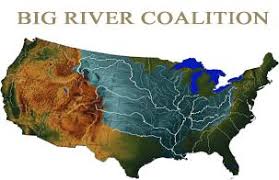The Big River Coalition is committed to protecting commerce across the Mississippi River and Tributaries (MRT). The Coalition focuses on maximizing transportation efficiencies on the deep-draft ship channel from Baton Rouge to the Gulf of Mexico. As concerns grow about the future management of the Mississippi River system and efforts are increased to help reduce or prevent adverse impacts related to flood protection, protecting water supplies, recreational boating, fishing, invasive species, coastal restoration, and minimizing the negative impacts of runoff and pollutants, it is critical to the nation’s economy that navigation remains unimpeded. The best economic estimates available indicate that the MRT has over a $735 billion annual impact on the economy of the United States. Therefore, as visions of the future of the MRT are shaped, it is imperative that navigation representatives strive to ensure that systematic approaches protect maritime trade by maintaining fully authorized channel dimensions while also updating and maintaining our navigation infrastructure, specifically the locks and dams along the MRT. The Big River Coalition missions are focused on securing increased funding from the Harbor Maintenance Tax and the Inland Users Fuel Tax, efforts to deepen the Lower Mississippi River to 50 feet and to increase the beneficial use of dredge material or “sediment recycling.”
The document UPDATED: 2020 Improvements Designed to Increase Channel Maintenance was prepared by the Big River Coalition and verified as accurate by the U.S. Army Corps of Engineers (USACE). There are two supporting documents here and here and a third that is made clickable for those interested in more details.
The 2020 Improvements Designed to Increase Channel Maintenance highlights the Mississippi River Ship Channel Deepening project, details that for the first time ever the USACE has three hopper dredges under contract prior to active shoaling for early 2021. Details increased funding is largely responsible for multiple benefits and that the dredge contractors are making significant capital investments to add both cutterhead and hopper dredges to the existing fleet. The USACE is also proceeding with recapitalization efforts for their hopper dredge McFARLAND. The successful beneficial use of dredged material project in the birds’-foot delta of the Mississippi River Delta is detailed and confirms that approximately 11,000 acres have now been restored since 2009 and highlights the amount of dredging projects in the area of Southwest Pass that the total is expected to eclipse 15,000 plus acres over the next 2-3 years. The final item offers an update on the South Atlantic Biological Opinion that will help to free up hopper dredges from the environmental windows.



